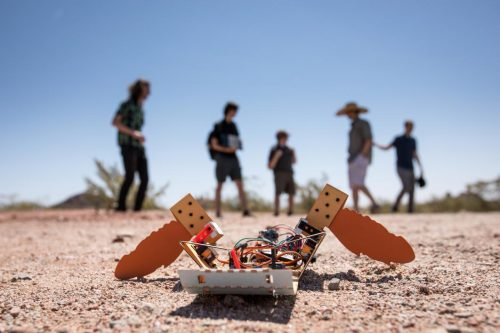By Jean-Jacques DeLisle, contributing writer
Machine learning, Raspberry Pis, and sea turtles are all exciting topics of conversation that don’t seem to have much in common. Amazingly, though, by combining the three, a group of researchers from Arizona State University turned a bout of interesting dialogue into a potential multi-functional and planet-trotting wonder. Along the way, the researchers made many discoveries, including how sea turtle flippers forged from millions of years of trial and error, which proved to be the most efficient way to move a massive lumbering turtle-like body around.

Turtles with machine-learning-based self-learning systems could be optimized for many different landscapes, including diverse terrestrial and even rough planetary landscapes, such as Mars. Image source: Charlie Leight/ASU Now.
The C-Turtle project started as an exploration of ways to combine computer science, biology, and engineering to solve design challenges. In this case, the goal was to devise a robot that could readily traverse sand and other loose, granular media of varying density and unknown composition. It’s a much more difficult task than it might seem. Conventional robotics design would attempt to use simulation to develop a locomotion strategy, then construct and program a robot to implement that strategy. This approach, however, can prove expensive and time-consuming and requires substantial robotics programming expertise to implement.
The ASU team chose a different approach. Rather than try to develop a strategy, their key to determining the most efficient method of locomotion was to build a low-cost robot that got a head start on solving the problem by copying from biology. In particular, the project from ASU took its inspiration from how real sea turtles move around on land.
They then gave the robot a self-learning computer algorithm that can work on a $10 Raspberry Pi, and one which could eventually arrive at the most effective way to move its flippers to get around. The Raspberry-Pi-powered and self-learning C-Turtle ended up with a very low-cost — roughly $70 dollars of parts, including the body frame and flippers — and with just an hour of training in sand pits or real terrain, the robot C-Turtles learn to propel themselves in the most efficient manner.
“From my point of view, it’s a fascinating approach,” said Heni Ben Amor, assistant professor in the School of Computing, Informatics, and Decision Systems Engineering. “If we use tricks from nature, it learns much faster. You can use that initial inspiration from nature to get things going.”
The team was interested in more than simply solving a locomotion challenge, though. The project was designed to be an exercise in developmental robotics to test a variety of hypotheses and answer questions. One of the questions revolved around whether or not a turtle’s flipper and body design elements were really efficient on land. A turtle uses flippers optimally designed for aquatic propulsion. For sea turtles living predominantly in the ocean — and who can reach several feet wide and hundreds to over a thousand pounds — dragging oneself across sand with soft, curved flippers doesn’t appear to make the most sense to provide good traction and efficient locomotion.
But the paddle-shaped flipper, as well as the turtle’s body with a curved lip and smooth underbelly shell beneath its massive bulk, proved to be very effective while on land. “Sea turtles are gigantic animals, and they move across sand pretty easily,” said Andrew Janssen, doctoral candidate in evolutionary biology who worked on the project and traced the profile of the sea-turtle flippers. “It turns out [that] the flippers shaped like the turtles’ work better than just a square paddle. We tested things that are impossible in nature. They didn’t work.”
The low-cost framework and self-learning algorithm allowed the researchers to quickly try out a variety of flipper design options and have the robot evolve the most efficient locomotion style that it could achieve with each design. Their results will be presented as two papers about the C-Turtle project this summer at MIT and Stanford. One paper will compare the robot design to the biological inspiration, and the other will describe the algorithmic learning process in both lab and real terrain conditions.
In the meantime, the team is already thinking about possible applications for C-Turtle-inspired robots. Because it can quickly adapt its locomotion to the terrain it is in, the robot can serve as transport in planetary exploration such as on Mars, where the characteristics of the surface are not well-known in advance. On the other hand, the robot’s low cost makes it suitable for risky ventures such as looking for landmines. A swarm of robots can adapt themselves to the terrain and then sweep an area, and if something goes “boom,” the loss is minimal.
ASU’s multidisciplinary experimental project is part of a long list of biology-inspired robotic and machine-learning discoveries. The U.S. military has also been exploring biologically inspired flying robots and drones to solve many of the latest robotic challenges. As machine-learning techniques evolve, it’s likely that computer resources will become smaller, cheaper, and easier to program. From planetary exploration to swarm robotic landmine sensing, the possibilities are endless.
Advertisement
Learn more about Electronic Products Magazine





